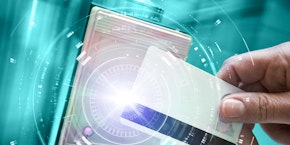Access control in the company

Topics overview:
There are various reasons why access to certain areas in a company should be regulated or prevented for some employees and external persons but the prime concern is security – of persons, material assets and data. Giving only authorised employees access to production, development or warehouse facilities will give better control of important information, company secrets or material assets. Sometimes this authorisation is only granted for a limited period of time. Access by unauthorised persons should, of course, be prevented completely. There is also a health and safety aspect when access control aims to prevent workplace accidents and ensure occupational safety.
The Covid-19 pandemic has brought additional requirements. In the case of automatic access control, for example, this can include checking the number, mask requirement and body temperature of the persons entering. The number of persons will be automatically determined to comply with prevailing Covid-19 regulations. Historical data for an official inspection can also be retrieved to meet requirements.
Warehouse planning
Checkliste: Systeme der Zutrittskontrolle
In unserer Gegenüberstellung „Systeme der Zutrittskontrolle“ erfahren Sie mehr Details über die Verfahren und Geräte.
Methods and devices for access control
For access control and data collection, a distinction is usually made between four different reading methods – each having different advantages, though often several methods are combined. These are:
RFID transponder and RFID chip reading
Biometric reading (using fingerprint, iris scan or facial recognition)
Magnetic card reading
Keypad PIN code entry.
Access control systems comprise at least three components: the identification device, the card reader and the access control unit.
The means of identification can be, for example, a badge, a wristband or any object or solution with an RFID chip. The card reader records the identification data and passes it on to a door controller or an access control centre for evaluation or administration. The access control unit checks the access authorisation and grants or denies release of the door, even without a permanent connection to the to the higher-level access control centre. The door is released by an electric trigger, a motor lock or an electric door drive.
Transponder reading method:
The contactless reading of (passive) RFID transponders – integrated in a chip card for example – is usually carried out with the card reader over a distance of anything from a few centimetres up to one metre. A passive transponder is an electronic identification medium and does not require a battery. It therefore has an almost unlimited lifespan and can be read through all non-metallic materials regardless of the reading angle, light or other environmental influences. The reader builds up an electromagnetic field that activates the transponder, causing it to send back its information also by means of electromagnetic waves. This information is decoded by the reader and shown on a display or forwarded to a door controller or an access control centre for evaluation and management. The system can be combined with biometric procedures or PIN entry. Transponders can even be surgically implanted under the skin. Near Field Communication (NFC) chips already exist for use as implants on humans. Originally created to register pets and assign them to a specific owner, NFC implants are also often used for breeding animals as an alternative to ear tags.
Biometric reading methods:
Unique biometric data is recommended for access control to sensitive high-security areas, such as research laboratories or prisons. This technology uses biometrics and scans of, for example, fingerprints, irises, retinas, palms, veins or facial features.
Biometric data offers several advantages: high security, consistent availability (it is not reliant on memory) simple and convenient handling, forgeries and copying are not possible. In addition, technology such as fingerprint readers is self-cleaning.
Magnetic card reading method:
Magnetic cards remain a very common means of access control. They are often found in hotels but are also used in companies for recording working hours. The magnetic stripe card is simply pulled through the card reader at the door or placed on the reader device. The integrated sensor in the card reader sends the data to the control centre and, if authorised, the door is opened electronically. The prime advantage of the magnetic card is its low cost. Since magnetic stripe cards must have direct contact with the reader when being read, they have a higher level of security than RFID cards. There are two card variants that differ in the magnetic flux density with which they are written: LoCo (Low Coercivity) with 300 Oe (Oersted) and HiCo (High Coercivity) with 2750 or 4000 Oe. With LoCo magnetic strips data can be accidentally erased from the outside by magnetic fields. This is almost impossible with HiCo magnetic strips, which is why they are preferred for identity cards.
Access control with keypad for PIN entry:
PIN codes are mainly used in small business units or in high security zones of large companies. Access is granted by means of a valid numerical code, which is entered via the keypad. Systems such as PIN entry and RFID transponders are often combined. After an authorised transponder is presented or an unlocked PIN code is entered, the relay contact in the door control unit to the door opener is closed or the switching output is activated. Alternatively, the transponder with RFID chip or PIN codes can be stored in the code lock. The transponder and PIN codes are authorised directly at the reader in the door control unit. If access is granted, the buttons or LEDs flash green. If access is denied, the buttons / LED flash red. The keypads are weatherproof and frost-proof and are therefore suitable for both indoor and outdoor use.



